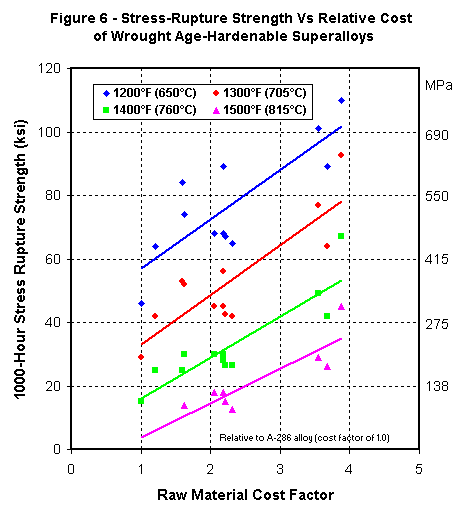Selection of Age-Hardenable Superalloys
Technical Guide
Superalloys are high-performance materials designed to provide high mechanical strength and resistance to surface degradation at high temperatures of 1200°F (650°C) or above. They combine high tensile, creep-rupture, and fatigue strength; good ductility and toughness, with excellent resistance to oxidation and hot corrosion. Furthermore, superalloys are designed to retain these properties during long-term exposures at the elevated temperatures.
This article focuses on the wrought age-hardenable alloys, which are the most commonly used superalloys. Wrought materials can be formed using hot and cold working operations. Not discussed here are the cast, powder (P/M), and oxide dispersion strengthened (ODS) superalloys that can also offer enhanced properties.
The first age-hardenable, high-temperature alloy dates back to about 1929 when various developers added titanium and aluminum to the standard 80% nickel/20% chromium resistance wire alloy. This was a precursor to the 80A nickel-base superalloy, developed in 1940-1944, but still in use today.
Little was done to advance the original age-hardenable alloys until the time period of 1935-1944 when World War II spurred demand for improved alloys that could be used in the early aircraft gas turbine engines. Alloy development activity exploded in the 1950’s and 1960’s to keep pace with the demands of the gas turbine engine industry. Progress in superalloy development not only made the jet engine possible, but allowed for constantly increasing thrust-to-weight ratios over the last 60 years.
Applications
The primary application for superalloys is still in hot sections of aircraft gas turbine engines, accounting for over 50% of the weight of advanced engines. However, the excellent performance of these materials at elevated temperatures has expanded their application far beyond one industry.
In addition to the aerospace industry, these alloys are used in turbine engines for marine, industrial, land-based power generation, and vehicular applications. Specific engine parts using superalloys include turbine discs, blades, compressor wheels, shafts, combustor cans, afterburner parts and engine bolts.
Beyond the gas turbine engine industries, superalloys are commonly used for applications in rocket engines, space, petrochemical/energy production, internal combustion engines, metal forming (hot-working tools and dies), heat-treating equipment, nuclear power reactors, and coal conversion.
While these alloys are primarily used for service at elevated temperatures above 1000°F (540°C), the characteristics of high strength and excellent environmental resistance have made some superalloys an excellent choice for lower-temperature applications. Examples are prosthetic devices in the medical industry and components for deep sour gas wells in the oil/gas exploration industry.
Chemical Composition
Table 1 contains the nominal compositions of the most common wrought age-hardenable superalloys. These alloys contain various combinations of nickel, iron, cobalt, and chromium with lesser amounts of other elements including molybdenum, niobium, titanium, and aluminum. With minor additions of beneficial elements such as boron and zirconium, these alloys may contain up to 12 intentional additions. All these additions help to impart and maintain the desired properties at elevated temperatures.
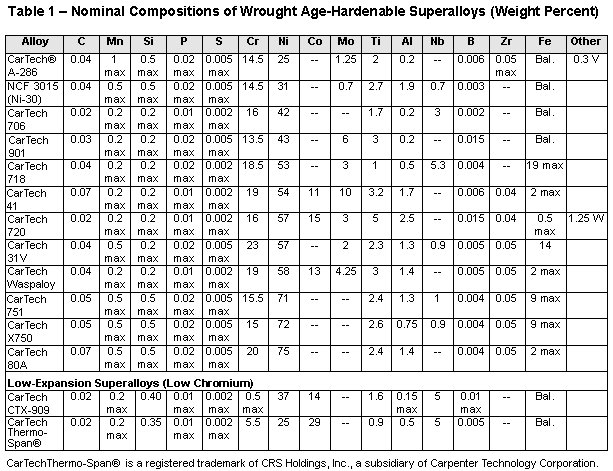
Many other elements such as silicon, phosphorus, sulfur, oxygen, nitrogen and a larger number of tramp elements (like lead, bismuth, selenium) must be tightly controlled in superalloys to avoid detrimental effects on high-temperature properties. These minor and tramp elements are controlled during raw material selection prior to melting, as well as during the melting/remelting processes.
Superalloys can be classified into nickel-base, iron-base, and cobalt-based groups. Nickel-based superalloys (>50% Ni) are the most common group. About half of the alloys in Table 1 are considered nickel-base alloys and the others contain large additions of nickel. The nickel base has a high tolerance for alloy additions that might otherwise cause phase instability leading to loss of strength, ductility, and/or environmental resistance.
Iron-based superalloys are less costly, but are less tolerant of alloying additions and typically have lower mechanical properties and maximum temperature limitations. Examples are CarTech® Alloy A-286 and CarTech NCF 3015 (Ni-30) alloy. These alloys contain an austenitic stainless steel base with additions of nickel, titanium, and aluminum to promote age hardening. CarTech Alloy 706 and CarTech 901 Alloy have similar amounts of nickel and iron and can be considered nickel-iron-base superalloys. The higher nickel levels of CarTech 901 and CarTech 706 alloys allow for larger additions of strengthening elements without undesirable effects.
Although there are some cobalt-base superalloys, they are significantly higher in cost and typically cannot be age hardened to high strength levels. However, cobalt is an important alloying addition to nickel-based alloys because it extends the maximum temperature for usage by reducing the solubility of the age-hardening phase. CarTech Waspaloy and CarTech 41 Alloy and CarTech 720 alloy are nickel-base alloys with 10-15% cobalt additions. These alloys have the highest temperature capability of the common wrought age-hardenable superalloys.
Chromium, usually in the range of 14 to 23 weight percent, is a critical alloying addition to nearly all superalloys. As in stainless steels, chromium forms a tightly-adherent, protective oxide film (Cr2O3) on the alloy surface to resist oxidation and corrosion at high temperatures as well as corrosion at lower temperatures. This surface layer protects the alloy from the harmful effects of the elements oxygen, nitrogen, and sulfur.
Although most superalloys contain at least 14% chromium, in some applications, it is critical to minimize thermal expansion. CarTech CTX-909 and CarTech Thermo-Span® alloys are considered low-expansion superalloys that have low chromium contents to minimize expansion of the nickel-cobalt-iron base. Resistance to oxidation and hot corrosion are reduced so high-temperature coatings are often applied prior to service. Of the two alloys, 909 alloy provides the lowest expansion coefficient while CarTech Thermo-Span alloy (5.5% chromium) provides improved environmental resistance.
Refractory elements like molybdenum, tungsten, and niobium, with their large atomic diameters, increase high temperature strength and stiffness by straining the nickel/iron base matrix. Alloys 901 and 41 contain larger additions of molybdenum to increase this solid solution strengthening effect. Other alloying additions such as chromium and aluminum also contribute to solid solution strengthening but to a lesser extent.
The elements titanium, aluminum, and niobium are added to the nickel or nickel-iron matrix to form an intermetallic Ni3 (Al, Ti, Nb) phase during age-hardening heat treatments. The resultant gamma prime or gamma double prime phases are the primary strengthening agents in superalloys. This will be discussed in more detail in the next section on age-hardening.
Although elements such as boron, zirconium, and magnesium may be added at levels less than 0.1 weight percent, the beneficial effects can be very potent. These elements segregate to and stabilize grain boundaries, which significantly improves hot workability, high temperature strength and ductility. Small additions of carbon also may be added to form carbides that restrict grain growth and grain boundary sliding during high temperature exposure.
Age-Hardening
The major strengthening method in superalloys is age-hardening. Yield strength of nickel alloys is typically increased by a factor of two or three by precipitation of the gamma prime and/or gamma double prime, Ni3 (Al, Ti, Nb) hardening phase. Although the phase is based on the nickel aluminide (Ni3Al) intermetallic, up to 60% of the aluminum can be replaced by titanium or niobium, which actually increases strength of the alloy.
The gamma prime phase is rather unique in that its strength actually increases with temperature up to 1200°F (650°C) and it is relatively ductile and resistant to oxidation. Gamma prime precipitates as very fine spheroidal or cuboidal particles in the nickel-iron matrix during aging.
While most of the superalloys employ the titanium-rich gamma prime phase for age hardening, a niobium-rich variant called gamma double prime is the primary strengthening phase in some superalloys such as CarTech Alloy 706 and CarTech 718 alloy. The niobium-rich phase provides higher strength up to 1200°F (650°C) but is unstable above 1200°F. Thus, 706 and 718 alloys have a lower temperature limit than the alloys strengthened with the titanium-rich gamma prime phase. Since the gamma double prime reaction is more sluggish, these alloys also tend to have better hot workability and weldability.
Heat Treatment
Proper heat treatment is critical to achieving the desired level of properties in age-hardenable superalloys. Typical heat treatments for these alloys are listed in the mechanical property Tables 2 and 3. The initial solution heat treatment typically dissolves all precipitated phases except for some primary carbide and nitride phases. The typical range for the wrought age-hardenable superalloys is 1650-2100°F (900-1150°C) for 1 to 4 hours followed by a rapid air cool or a quench in water, polymer or oil.
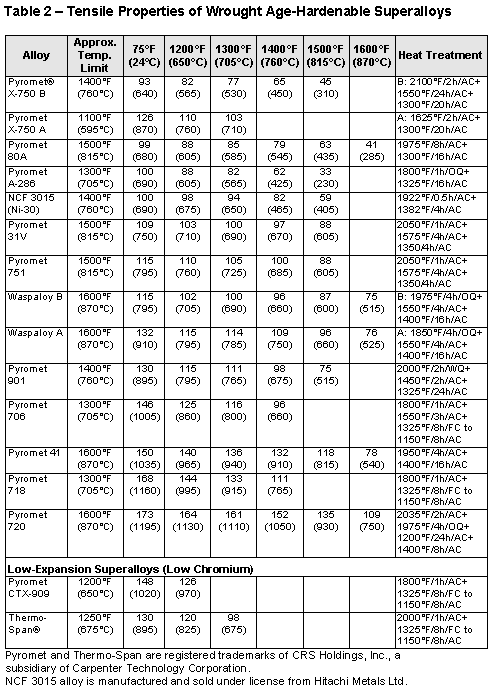
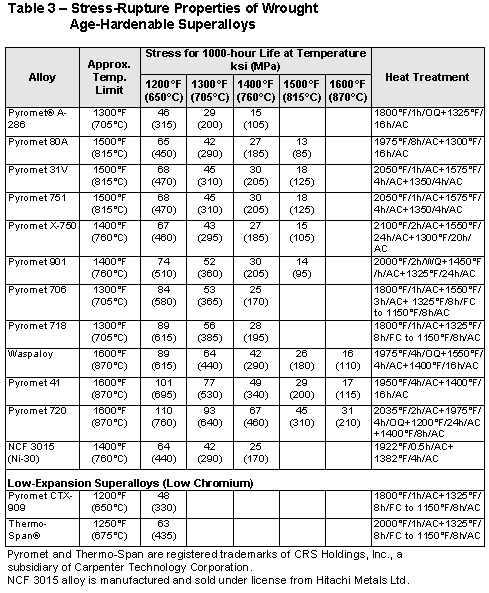
The selection of solution treatment time and temperature varies with the alloy and its phase solvus temperatures, and also depends on the specific properties that are most important for the intended application. Alloys with higher hardener contents (Ti, Al, Nb) require higher temperatures to solution any hardener phase that may have precipitated during hot working or cooling. Best tensile and fatigue properties are typically obtained with lower solution temperatures that result in a finer grain size. In contrast, better long-term stress-rupture and creep properties are generally obtained with higher-temperature solution treatments that result in coarser grain size and lower tensile yield strength. For these reasons, it is common to specify two or more preferred heat treatments for superalloys.
In some cases, another objective of the solution treatment is to form a desirable distribution of a second phase such as carbide in CarTech 41 alloy and delta phase (Ni3Nb) in CarTech 718 alloy. After solution treatment, one or more aging treatments are applied to precipitate the hardening phase and possibly other phases in the desired amount and distribution. As with solution treatment, the selection of aging temperatures is dependent on the alloy and the combination of properties desired.
The aging range for age-hardenable superalloys is 1150-1600°F (620-870°C). Aging times range from 4 hours to 24 hours. Double-aging treatments are quite common to maximize strength and to develop the best combination of short-term tensile and long-term creep-rupture properties. The primary aging treatment precipitates a coarser distribution of the hardener phase and may also improve the type and distribution of carbides on grain boundaries.
The secondary age is typically about 200°F below the primary aging temperature, precipitating a finer dispersion of the gamma prime phase. For some higher-strength applications, the alloy is direct aged after hot, warm, or cold working without an intermediate solution treatment. The strain from working is used to further enhance tensile and fatigue properties with some sacrifice in creep-rupture properties.
Mechanical Properties
For the design engineer or materials specifier, a review of terms defining applicable mechanical properties may be helpful:
Tensile Properties – The design of load-bearing structures is often based on yield strength or, in some cases, the ultimate tensile strength of the material. Yield strength is a measure of the maximum stress a material can withstand before it permanently deforms. Tensile strength is a measure of the maximum stress a material can withstand before it fractures. Elevated temperature tensile properties are most applicable to short-time exposures at higher temperatures. Creep and stress-rupture properties are more applicable for longer exposures.
Creep and Rupture Properties – Creep and rupture strengths become important when the material must withstand the combined effects of high temperature and stress for long periods of time. At elevated temperatures, metals will stretch or "creep" at stresses well below the yield strength. Superalloys are more resistant to creep than low-alloy or stainless steels, but creep will still occur above about 1000°F (540°C). Creep properties are a measure of the alloy’s resistance to stretching under a constant load. Stress-rupture or creep-rupture properties are a measure of resistance to fracture under a constant load (creep test taken to fracture). Both properties are expressed as stress or strength values that will cause a given amount of creep (0.1%-1%) or rupture in a given amount of time (100 to 100,000 hours).
Tables 2 and 3 list typical tensile (yield) and stress-rupture strength properties of the age-hardenable superalloys at temperatures of 1200-1600°F (650-870°C). Yield strengths at room temperature are also listed in Table 2. These properties are shown graphically in Figures 1 and 2. It should be noted that the data represents approximate nominal strength values for specific heat treatments. Actual values can vary by up to 35% due to differences in composition, hot/cold working practices, and heat treatment.
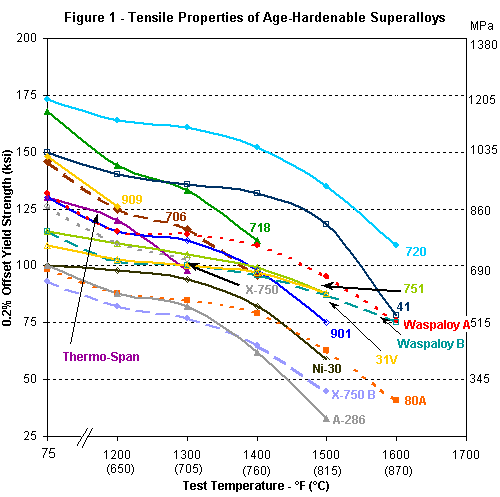
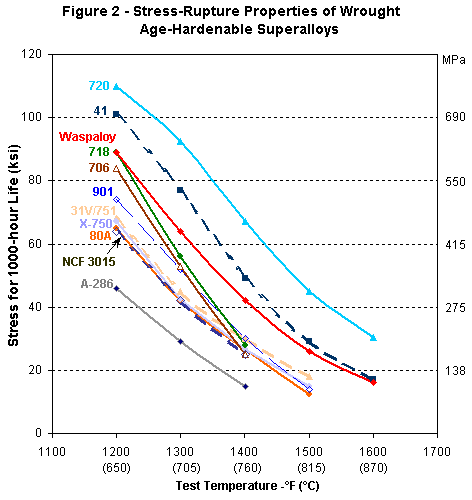
For example, superalloys like CarTech 718 and CarTech Waspaloy may contain several different aim compositions within the broader industry ranges to optimize properties for specific applications. Higher levels of the age-hardening elements titanium, aluminum, and niobium result in higher strength. Hot or cold working an alloy to obtain a finer grain size typically increases tensile yield strength but decreases stress-rupture strength.
As discussed previously, properties of all age-hardenable superalloys are dependent on heat treatment. Alloys like CarTech X-750 alloy and CarTech Waspaloy have two or more preferred heat treatments (see Table 2) depending on whether the application requires better short-time tensile and fatigue properties or long-time creep and stress-rupture properties. Examples of alternative heat treatments have been shown for CarTech Waspaloy and CarTech X-750 alloys but the reader should refer to manufacturers’ datasheets for a more complete listing of alternative heat treatments for the other superalloys.
Other Properties – While tensile and creep-rupture are the most basic mechanical properties considered for high-temperature applications, design criteria may also consider resistance to fatigue (low- and high-cycle), crack growth, and wear/erosion. Hardness and hot hardness tests are sometimes used as a rough measure of yield strength and wear/erosion.
While tensile and creep-rupture are the most basic mechanical properties considered for high-temperature applications, design criteria may also consider resistance to fatigue (low- and high-cycle), crack growth, and wear/erosion. Hardness and hot hardness tests are sometimes used as a rough measure of yield strength and wear/erosion.
Alloy Selection
A simplified method known as the Carpenter Selectaloy® system can help designers and engineers select the most suitable superalloy based on strength and maximum temperature requirements. Figures 3 and 4 contain Selectaloy diagrams for the 15 superalloys discussed in this article. Yield strength (Figure 3) or stress-rupture strength (Figure 4) increases vertically on the Selectaloy diagram, and temperature increases from left to right. The alloys are shown multiple times on the diagrams since the alloys are useful over a range of temperatures. The diagram can be used to estimate how the strength of an alloy decreases with temperature, but also how the strength of different alloys compare at different temperatures.
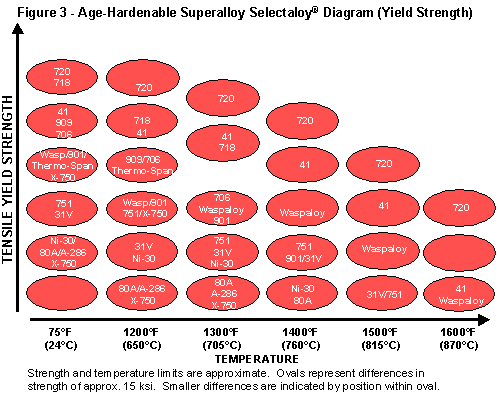
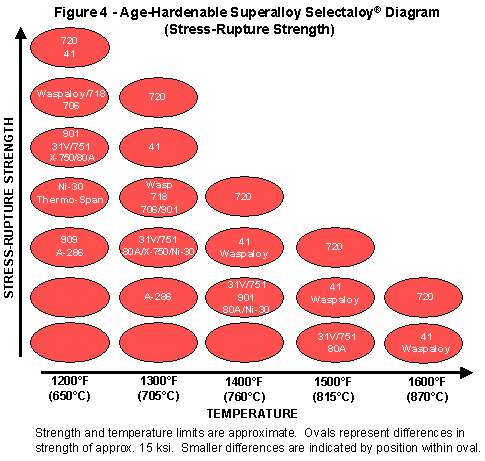
It should be noted that the alloys were positioned on the Selectaloy diagrams based on average strength values representative of compositions and heat treatments commonly used for each alloy. An alloy’s relative position could move up or down, left or right, with relatively minor modifications of composition, processing and heat treatment. Temperature limits should be considered approximate. Therefore, while the Selectaloy diagrams are useful tools to screen candidate alloys, they are not a substitute for a more detailed evaluation of the critical properties required for an intended application.
CarTech A-286 alloy is the most basic age-hardenable superalloy in terms of properties and cost. CarTech A-286 provides the lowest strength levels, but still higher by a factor of two than other non-age-hardenable stainless alloys. When increased strength or temperature resistance is required, higher nickel alloys are typically preferred. Alloys with the highest levels of strength and temperature resistance typically contain the highest alloy contents and significant levels of cobalt. Relative cost of these alloys will be discussed in the next section.
alloy is the most basic age-hardenable superalloy in terms of properties and cost. A-286 provides the lowest strength levels, but still higher by a factor of two than other non-age-hardenable stainless alloys. When increased strength or temperature resistance is required, higher nickel alloys are typically preferred. Alloys with the highest levels of strength and temperature resistance typically contain the highest alloy contents and significant levels of cobalt. Relative cost of these alloys will be discussed in the next section.
The Selectaloy diagrams presented in this article provide a method to compare basic strength properties and temperature limitations of common wrought age-hardenable superalloys. However, alloy selection will undoubtedly depend on many other considerations, including other physical and mechanical properties as well as environmental resistance and cost. For example, CarTech Thermo-Span and CarTech CTX-909 alloys provide a benefit of much lower expansion during heating but at the expense of oxidation and corrosion resistance in the uncoated condition. CarTech 31V and CarTech 751 alloys provide similar strength and temperature resistance, but the higher chromium content of 31V alloy results in much improved resistance to sulfidation and other forms of hot corrosion.
Alloy Cost
From the user’s standpoint, alloy selection must be based on expected cost effectiveness.
In today’s competitive global environment, overdesign is less common. The trend is to select the lowest-cost material to meet design requirements for the application. However, a higher-cost alloy may be justified to minimize overall life cycle cost or for longer service of certain components in a system that is critical or too expensive to be shut down for maintenance. Surely, knowledge of alloy capabilities is critical in making the best decision.
As temperature and strength requirements increase, so does the necessary alloy content. Figure 5 compares the relative alloying costs of the 14 alloys using CarTech A-286 alloy as a base (cost factor of 1.0). The cost factors are based on 10-year averages of the intrinsic alloying element costs at market prices. Higher temperature strength and resistance typically require higher nickel and cobalt contents. Nickel and cobalt prices have historically been volatile, with high and low prices varying by a factor of 4 to 5. More recently, the price of molybdenum, a potent solid solution strengthener, has increased in price by a factor of nearly ten over the last two years.
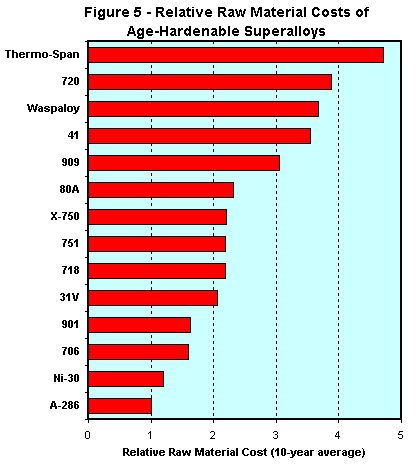
As discussed above, the cost factors in Figure 5 are based only on raw material elemental costs (10-year averages) that fluctuate significantly with time. Differences in melting, working, and other processing costs, which can be substantial, are not included in these factors. Processing yields and specific end user requirements (grain size, ultrasonic testing, etc.) significantly impact product cost. However, the cost comparisons are useful because alloying costs typically represent a large portion of superalloy product cost. Since superalloys are designed for high temperature strength and resistance to deformation, processing difficulty and cost also increase with hot strength and maximum temperature capability.
Figure 6 shows the relationships of stress-rupture strength at 1200-1500°F (650-815°C) with raw material cost factor. It is apparent that the alloys that provide higher levels of strength, temperature resistance, and/or specialized properties also cost more, which reinforces the importance of the alloy selection process.
